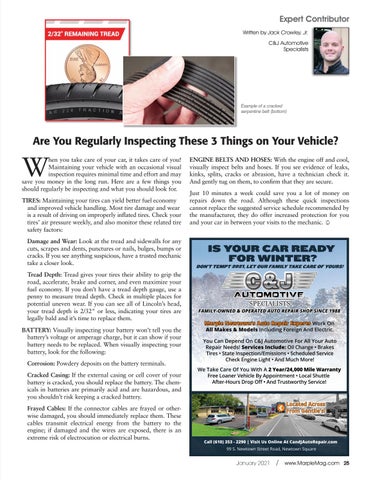Expert Contributor Written by Jack Crowley, Jr. C&J Automotive Specialists
Example of a cracked serpentine belt (bottom)
Are You Regularly Inspecting These 3 Things on Your Vehicle?
W
hen you take care of your car, it takes care of you! Maintaining your vehicle with an occasional visual inspection requires minimal time and effort and may save you money in the long run. Here are a few things you should regularly be inspecting and what you should look for.
TIRES: Maintaining your tires can yield better fuel economy and improved vehicle handling. Most tire damage and wear is a result of driving on improperly inflated tires. Check your tires’ air pressure weekly, and also monitor these related tire safety factors:
Damage and Wear: Look at the tread and sidewalls for any cuts, scrapes and dents, punctures or nails, bulges, bumps or cracks. If you see anything suspicious, have a trusted mechanic take a closer look.
Tread Depth: Tread gives your tires their ability to grip the road, accelerate, brake and corner, and even maximize your fuel economy. If you don’t have a tread depth gauge, use a penny to measure tread depth. Check in multiple places for potential uneven wear. If you can see all of Lincoln’s head, your tread depth is 2/32" or less, indicating your tires are legally bald and it’s time to replace them.
ENGINE BELTS AND HOSES: With the engine off and cool, visually inspect belts and hoses. If you see evidence of leaks, kinks, splits, cracks or abrasion, have a technician check it. And gently tug on them, to confirm that they are secure. Just 10 minutes a week could save you a lot of money on repairs down the road. Although these quick inspections cannot replace the suggested service schedule recommended by the manufacturer, they do offer increased protection for you and your car in between your visits to the mechanic. M
2021
BATTERY: Visually inspecting your battery won’t tell you the battery’s voltage or amperage charge, but it can show if your battery needs to be replaced. When visually inspecting your battery, look for the following: Corrosion: Powdery deposits on the battery terminals.
Cracked Casing: If the external casing or cell cover of your battery is cracked, you should replace the battery. The chemicals in batteries are primarily acid and are hazardous, and you shouldn’t risk keeping a cracked battery.
Frayed Cables: If the connector cables are frayed or otherwise damaged, you should immediately replace them. These cables transmit electrical energy from the battery to the engine; if damaged and the wires are exposed, there is an extreme risk of electrocution or electrical burns.
January 2021
/
www.MarpleMag.com 25











